cdxcore.dynaplot#
Tools for dynamic plotting in Jupyer/IPython.
The aim of the toolkit is making it easier to develop
animated visualization with matplotlib,
for example during training with machine learing kits such as
pyTorch.
This has been tested with Anaconda’s
JupyterHub and %matplotlib inline.
Overview#
It also makes the creation of subplots more streamlined.
The package now contains a lazy method to manage updates to graphs (animations). This is implemented as follows:
Create a figure with
cdxcore.dynaplot.figure(). Then callcdxcore.dynaplot.DynaFig.store()to return an “element store”.When creating new matplotlib elements such as plots, figures, fills, lines, add them to the store with
store +=. Do not add elements you wish to retain (for example legends if the dictionary of plots stays the same between updates).Call
cdxcore.dynaplot.DynaFig.render()to render all graphical elements. Do not callcdxcore.dynaplot.DynaFig.close().To update your elements (i.e. animation) call
cdxcore.dynaplot.FigStore.remove()to remove all old graphical elements (this function callsmatplotlib.axes.Axes.remove()).Then re-create the cleared elements, and call
cdxcore.dynaplot.DynaFig.render()again.When your animation is finished, call
cdxcore.dynaplot.DynaFig.close().If you do not call close, you will likely see unwanted copies of your plots in Jupyter.
Here is an example of animated line plots using cdxcore.dynaplot.DynaFig.store():
%matplotlib inline
import numpy as np
from cdxcore.dynaplot import figure # 'figure' is an alias for DynaFig
x = np.linspace(0,1,100)
pm = 0.2
fig = figure(col_size=10)
ax = fig.add_subplot()
ax2 = fig.add_subplot()
ax2.sharey(ax)
store = fig.store()
fig.render()
import time
for i in range(5):
y = np.random.random(size=(100,))
ax.set_title(f"Test {i}")
ax2.set_title(f"Test {i}")
store.remove() # delete all previously stored elements
store += ax.plot(x,y,":", label=f"data {i}")
store += ax2.plot(x,y,"-",color="red", label=f"data {i}")
store += ax2.fill_between( x, y-pm, y+pm, color="blue", alpha=0.2 )
store += ax.legend()
fig.render()
time.sleep(0.5)
fig.close()

This example shows the use of store with different elements.
Here is an example with
animated 3D plots, calling matplotlib.axes.Axes.remove() manually:
%matplotlib inline
import numpy as np
from cdxcore.dynaplot import figure # 'figure' is an alias for DynaFig
import math
x = np.linspace(0.,2.*math.pi,51)
y = x
fig = figure()
ax1 = fig.add_subplot(projection='3d')
ax2 = fig.add_subplot(projection='3d')
ax1.set_xlim(0.,2.*math.pi)
ax1.set_ylim(0.,2.*math.pi)
ax1.set_zlim(-2,+2)
ax1.set_title("Color specified")
ax2.set_xlim(0.,2.*math.pi)
ax2.set_ylim(0.,2.*math.pi)
ax2.set_zlim(-2,+2)
ax2.set_title("Color not specified")
fig.render()
r1 = None
r2 = None
import time
for i in range(50):
time.sleep(0.01)
z = np.cos( float(i)/10.+x )+np.sin( float(i)/2.+y )
if not r1 is None: r1.remove()
if not r2 is None: r2.remove()
r1 = ax1.scatter( x,y,z, color="blue" )
r2 = ax2.scatter( 2.*math.pi-x,math.pi*(1.+np.sin( float(i)/2.+y )),z )
fig.render()
fig.close()
print("/done")
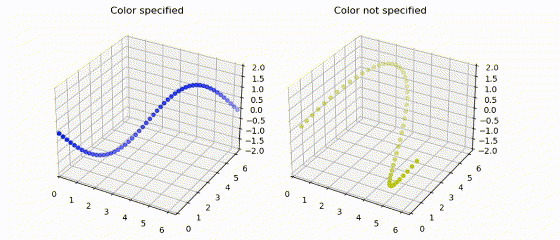
The jupyter notebook contains a few more examples.
Simpler sub_plot#
The package lets you create sub plots without having to know the number of plots in advance.
You have the following two main
options when creating a new cdxcore.dynaplot.figure():
Define as usual
figsize, and specify the number ofcolumns. In this case the figure will arrange plots you add withcdxcore.dynaplot.DynaFig.add_subplot()iteratively with at mostcolumnsplots per row.add_subplot()will not need any additional positional arguments.Instead, you can specify
col_size,row_size, andcolumns: the first two define the size per subplot. Like before you then add your sub plots usingcdxcore.dynaplot.DynaFig.add_subplot()without any additional positioning arguments.Assuming you add N subplots, then the overall
figsizewill be(col_size* (N%col_num), row_size (N//col_num)).
When adding plots with cdxcore.dynaplot.DynaFig.add_subplot() you can
make it skip to the first column in the next row,
by calling cdxcore.dynaplot.DynaFig.next_row().
The example also shows that we can specify titles for subplots and figures easily:
%matplotlib inline
import numpy as np
from cdxcore.dynaplot import figure # 'figure' is an alias for DynaFig
fig = figure(title="Multi Graph", columns=4)
ref_ax = None
x = np.linspace(0,1,100)
for k in range(9):
ax = fig.add_subplot(f"Test {k}")
y = np.random.random(size=(100,1))
ax.plot(x,y,":",color="red", label="data")
ax.legend(loc="upper left")
if not ref_ax is None:
ax.sharey(ref_ax)
ax.sharex(ref_ax)
else:
ref_ax = ax
fig.close()
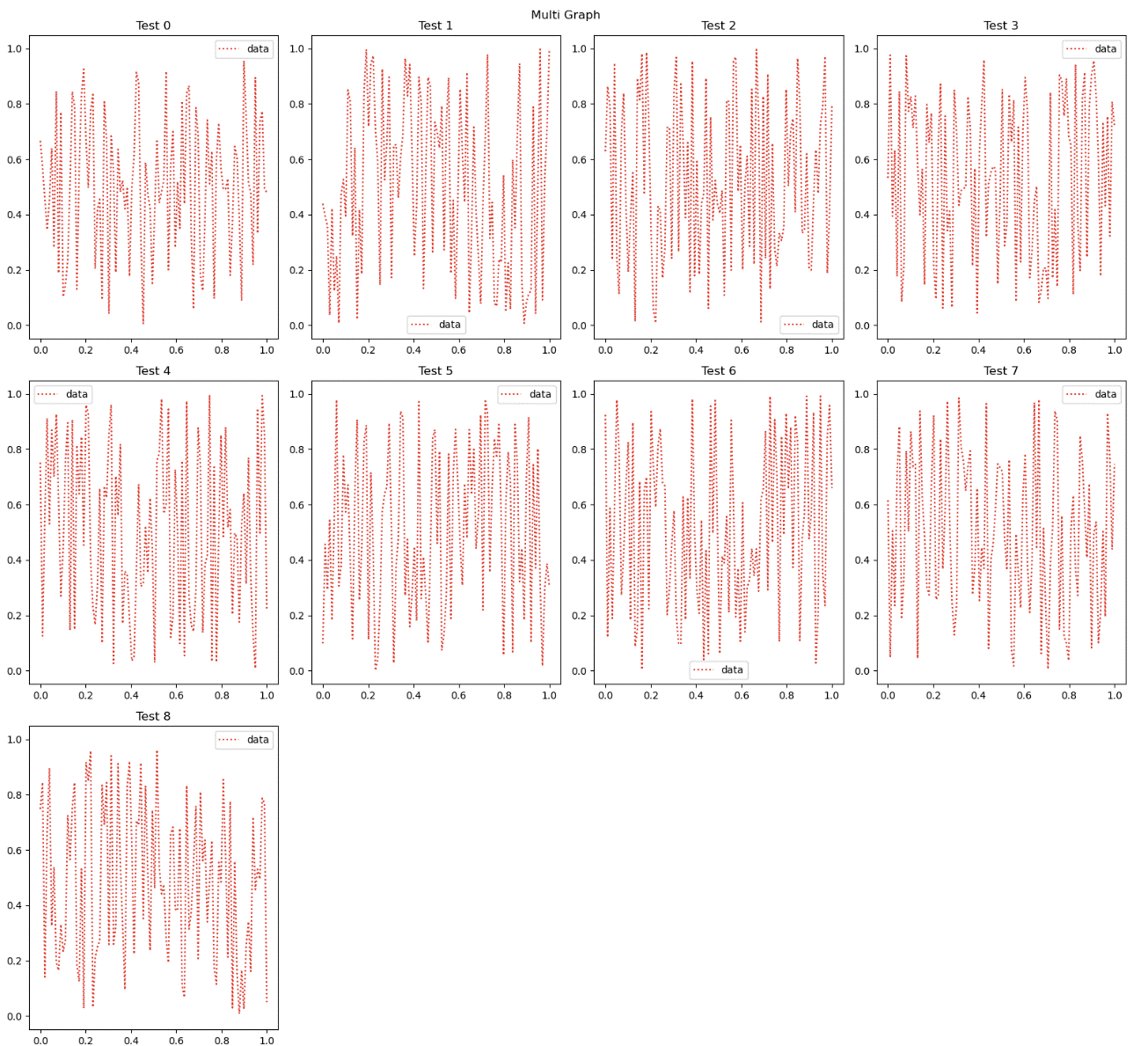
Grid Spec#
Another method to place plots is by explicitly positioning them using
a matplotlib.gridspec.GridSpec. In line with the paradigm
of delayed creation, use cdxcore.dynaplot.DynaFig.add_gridspec()
to generate a deferred grid spec.
Example:
%matplotlib inline
from cdxcore.dynaplot import figure
import numpy as np
x = np.linspace(-2.,+2,101)
y = np.tanh(x)
fig = figure("Grid Spec Example", figsize=(10,5))
gs = fig.add_gridspec(2,2)
ax = fig.add_subplot("1", spec_pos=gs[0,0] )
ax.plot(x,y)
ax = fig.add_subplot("2", spec_pos=gs[:,1] )
ax.plot(x,y)
ax = fig.add_subplot("3", spec_pos=gs[1,0] )
ax.plot(x,y)
fig.close()
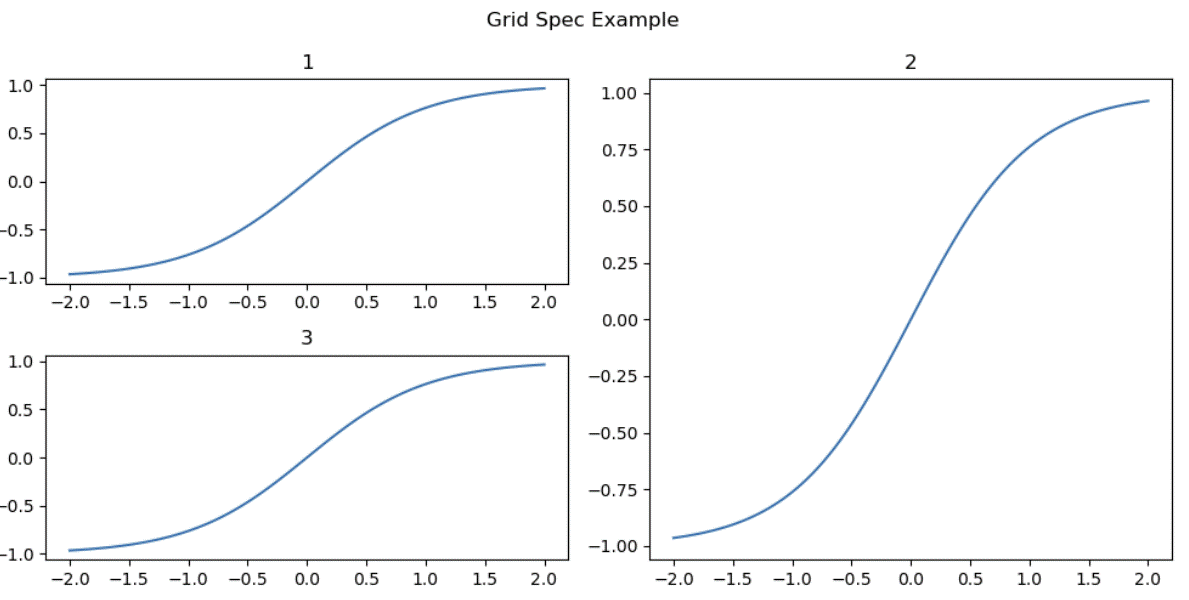
Color Management#
Use cdxcore.dynaplot.color_css4(), cdxcore.dynaplot.color_base(), cdxcore.dynaplot.color_tableau(), cdxcore.dynaplot.color_xkcd()
to return an i th element of the respective matplotlib color
table.
This simplifies using consistent colors accross different plots or when re-creating plots during an animation.
Example of using the same colors by order in two plots:
%matplotlib inline
import numpy as np
import math
import time
from cdxcore.dynaplot import figure, color_base # 'figure' is an alias for DynaFig
x = np.linspace(0.,2.*math.pi,51)
fig = figure(fig_size=(14,6))
ax = fig.add_subplot("Sin")
store = fig.store()
# draw 10 lines in the first sub plot, and add a legend
for i in range(10):
y = np.sin(x/(i+1))
ax.plot( x, y, color=color_base(i), label=f"f(x/{i+1})" )
ax.legend(loc="lower right")
# draw 10 lines in the second sub plot.
# use the same colors for the same scaling of 'x'
ax = fig.add_subplot("Cos")
for i in range(10):
z = np.cos(x/(i+1))
store += ax.plot( x, z, color=color_base(i) )
fig.render()
# animiate, again with the same colors
for p in np.linspace(0.,4.,11,endpoint=False):
time.sleep(0.1)
store.clear() # alias for 'remove'
for i in range(10):
z = np.cos((x+p)/(i+1))
store += ax.plot( x, z, color=color_base(i) )
fig.render()
fig.close()
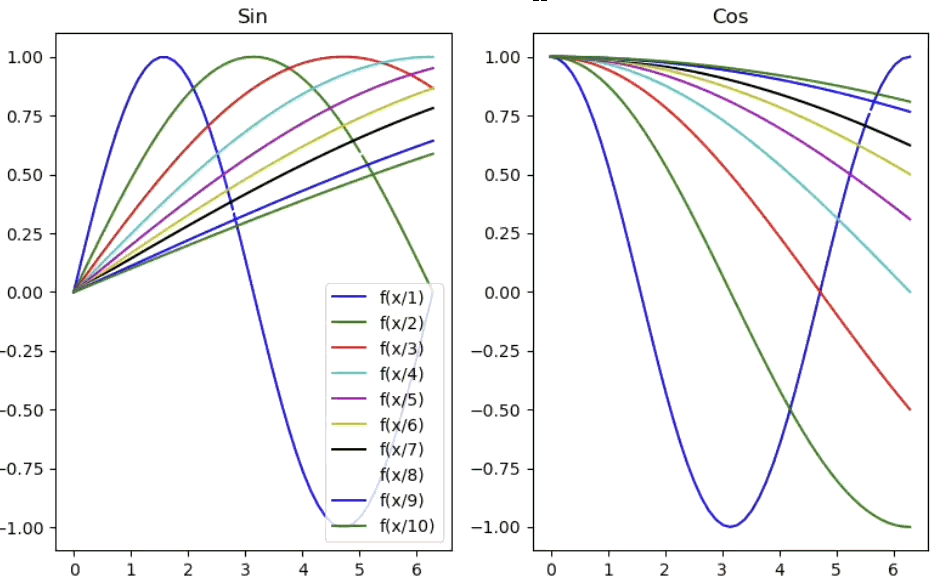
Here is a view of the first 20 colors of the four supported maps:
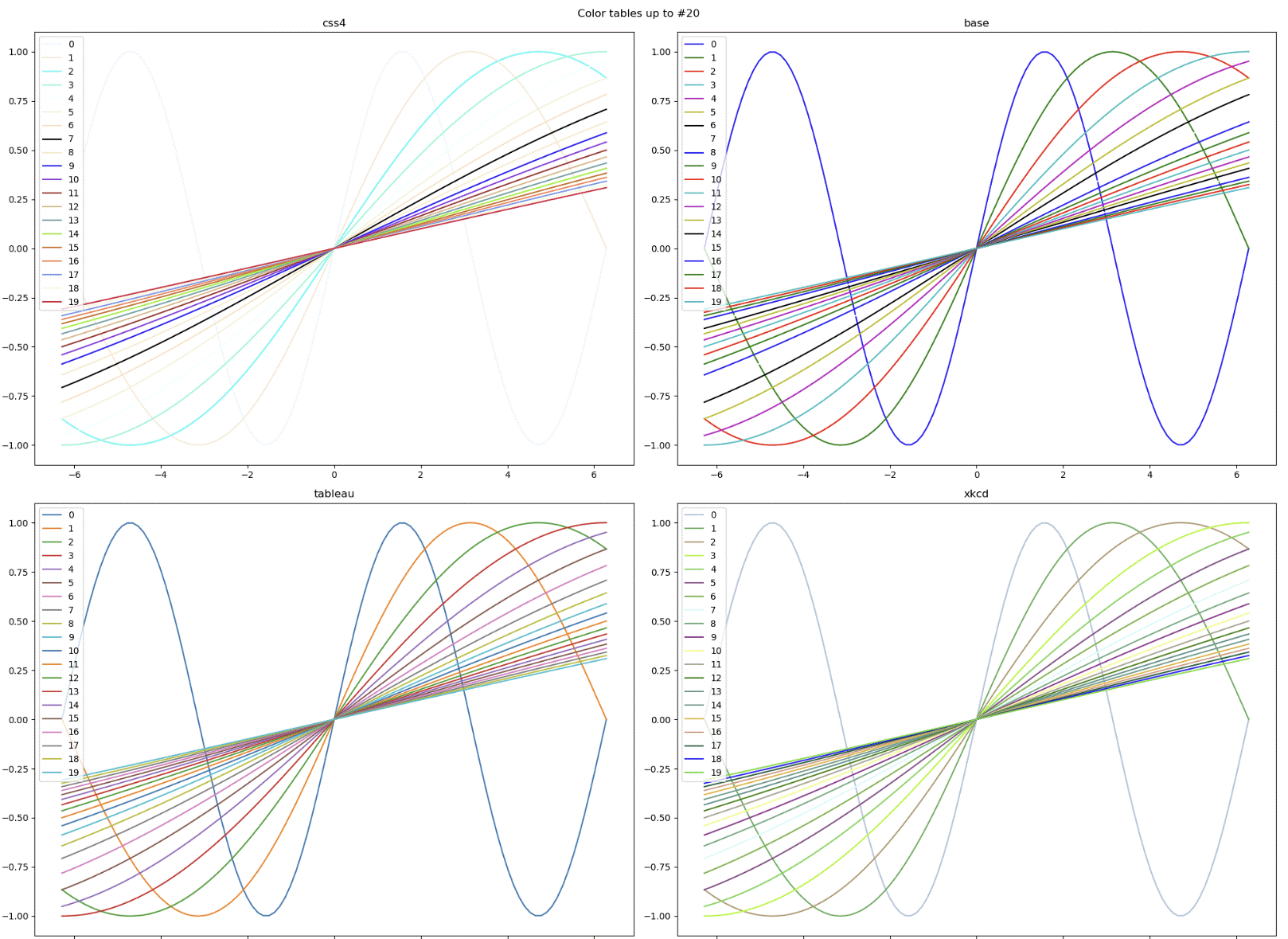
The classes cdxcore.dynaplot.colors_css4, cdxcore.dynaplot.colors_base, cdxcore.dynaplot.colors_tableau, cdxcore.dynaplot.colors_xkcd
are generators for the same colors.
Known Issues#
Some users reported that the package does not work in some versions of Jupyter, in particular with VSCode.
In this case, please try changing the draw_mode parameter when calling cdxcore.dynaplot.figure().
Import#
fronm cdxcore.dynaplot import figure
Documentation#
Module Attributes
List of available colors names. |
Functions
|
Returns a color with a given index to allow consistent colouring. |
|
Returns the i'th base color: |
|
Returns the i'th css4 color: |
Returns the i'th tableau color: |
|
|
Returns the i th xkcd color. |
|
Returns a generator for the colors of the specified table. |
Iterator for "base" matplotlib colors: |
|
Iterator for "css4" matplotlib colors: |
|
Iterator for ""tableau"" matplotlib colors:" |
|
Iterator for xkcd. |
|
|
Creates a dynamic figure of type |
|
Creates a |
Classes
|
Deferred wrapper around a |
|
Deferred wrapper around |
|
Utility class to manage dynamic content by removing old graphical elements (instead of using element-specifc update). |
|
How to draw graphs. |
- class cdxcore.dynaplot.DynaAx(*, fig_id, fig_list, row, col, spec_pos, rect, title, projection, kwargs)[source]#
Bases:
_DynaDeferredDeferred wrapper around a
matplotlib.pyplot.axisobjects returned bycdxcore.dynaplot.DynaFig.add_subplot()or similar.You should not need to know that this object is not actually a
matplotlib.pyplot.axis. If you receive error messages which you do not understand, please contact the authors of this module.- Attributes:
deferred_dependantsRetrieve list of dependant
cdxcore.deferred.Deferredobjects.deferred_infoText description of the current action.
deferred_resultReturns the result of the deferred action, if available.
deferred_result_or_selfReturns the result of the deferred action, if available, or
self.deferred_source_dependantsRetrieve list of dependant
cdxcore.deferred.Deferredobjects at the level of the original parent source.deferred_sourcesRetrieve a dictionary with information on all top-level sources this deferred action depends on.
deferred_sources_namesRetrieve a list of names of all top-level sources this deferred action depends on.
deferred_was_resolvedWhether the underlying operation has already been resolved.
Methods
Create(info)Create top level element.
__call__(*args, **kwargs)Create
__call__actionauto_limits(low_quantile, high_quantile[, ...])Add automatic limits using
cdxcore.dynalimits.AutoLimits.deferred_create_action(**kwargsa)Creates a deferred action created during another deferred action.
deferred_print_dependency_tree([verbose, ...])Prints the dependency tree recorded by this object and its descendants.
deferred_resolve(element[, verbose])Resolve the top level deferred element.
plot(*args[, scalex, scaley, data])Wrapper around
matplotlib.axes.plot().remove()Equivalent of
matplotlib.axes.Axes.remove(): removes this axis from the underlying figure.set_auto_lims(*args, **kwargs)Apply
cdxcore.dynalimits.AutoLimitsfor this axis.- auto_limits(low_quantile, high_quantile, min_length=10, lookback=None)[source]#
Add automatic limits using
cdxcore.dynalimits.AutoLimits.- Parameters:
- low_quantilefloat
Lower quantile to use for computing a ‘min’ y value. Set to 0 to use the actual ‘min’.
- high_quantilefloat
Higher quantile to use for computing a ‘min’ y value. Set to 1 to use the actual ‘max’.
- min_lengthint, optional
Minimum length data must have to use
numpy.quantile(). If less data is presented, use min/max, respectively. Default is10.- lookbackint
How many steps to lookback for any calculation.
Noneto use all steps.
- plot(*args, scalex=True, scaley=True, data=None, **kwargs)[source]#
Wrapper around
matplotlib.axes.plot().This function wrapper does not support the
datainterface ofmatplotlib.axes.plot().If automatic limits are not used, this is a wrapper with deferred pass-through. If automatic limits are used, then this function will update the underlying automated limits accordingly.
- Parameters:
- args, scalex, scaley, data, kwargs…
See
matplotlib.axes.plot().
- Returns:
- plot
Deferred This function will return a wrapper around an actual
axiswhich is used to defer actioning any subsequent calls to untilcdxcore.dynaplot.DynaFig.render()is called.You should not need to consider this. If you encounter problems in usability please contact the authors.
- plot
- remove()[source]#
Equivalent of
matplotlib.axes.Axes.remove(): removes this axis from the underlying figure. Note that this will not trigger a removal from the actual visualization untilcdxcore.dynaplot.DynaFig.render()is called.
- class cdxcore.dynaplot.DynaFig(title=None, *, row_size=5, col_size=4, fig_size=None, columns=5, tight=True, draw_mode=1, **fig_kwargs)[source]#
Bases:
_DynaDeferredDeferred wrapper around
matplotlib.pyplot.figure.Wraps matplotlib
matplotlib.pyplot.figure. Provides a simplecdxcore.dynaplot.DynaFig.add_subplot()without the need to pre-specify axes positions as is common formatplotlib.See
cdxcore.dynaplot.figure()for more information.- Attributes:
deferred_dependantsRetrieve list of dependant
cdxcore.deferred.Deferredobjects.deferred_infoText description of the current action.
deferred_resultReturns the result of the deferred action, if available.
deferred_result_or_selfReturns the result of the deferred action, if available, or
self.deferred_source_dependantsRetrieve list of dependant
cdxcore.deferred.Deferredobjects at the level of the original parent source.deferred_sourcesRetrieve a dictionary with information on all top-level sources this deferred action depends on.
deferred_sources_namesRetrieve a list of names of all top-level sources this deferred action depends on.
deferred_was_resolvedWhether the underlying operation has already been resolved.
Methods
Create(info)Create top level element.
__call__(*args, **kwargs)Create
__call__actionadd_axes(rect[, title, projection])Add a freely placed sub plot.
add_gridspec([ncols, nrows])Wrapper for
matplotlib.figure.Figure.add_gridspec(), returning a deferedGridSpec.add_plot([title, new_row, spec_pos, projection])Adds a subplot.
add_subplot([title, new_row, spec_pos, ...])Adds a subplot.
close([render, clear])Closes the figure.
deferred_create_action(**kwargsa)Creates a deferred action created during another deferred action.
deferred_print_dependency_tree([verbose, ...])Prints the dependency tree recorded by this object and its descendants.
deferred_resolve(element[, verbose])Resolve the top level deferred element.
delaxes(ax, *[, render])Equivalent of
matplotlib.figure.Figure.delaxes(), but this function can also take a list.get_axes()Equivalent to
self.axesnext_row()Skip to next row.
remove_all_axes(*[, render])Calles
cdxcore.dynalot.DynaAx.remove()for all axesrender([draw])Draw all axes.
savefig(fname[, silent_close])Saves the figure to a file.
store()Create a FigStore().
to_bytes([silent_close])Convert figure to a byte stream.
- add_axes(rect, title=None, *, projection=None, **kwargs)[source]#
Add a freely placed sub plot.
Like
matplotlib.figure.Figure.add_axes()this function allows placing a plot at a given position within a figure usingrect. This plot may overlay previously generated plots.This function can be called after the
cdxcore.dynaplot.DynaFig.close()was called.Note that using this function with a
tightfigure will result in aUserWarning. Usetight=Falsewhen constructing your figure to avoid this warning.- Parameters:
- recttuple (left, bottom, width, height)
The dimensions (left, bottom, width, height) of the new plot. All quantities are in fractions of figure width and height.
- titlestr, optional
Title for the plot, or
Nonefor no plot.- projectionstr, optional
What
projectionto use. The defaultNonematches the default choice formatplotlib.figure.Figure.add_axes()- args, kwargs
keyword arguments to be passed to
matplotlib.figure.Figure.add_axes().
- add_gridspec(ncols=1, nrows=1, **kwargs)[source]#
Wrapper for
matplotlib.figure.Figure.add_gridspec(), returning a deferedGridSpec.
- add_plot(title=None, *, new_row=None, spec_pos=None, projection=None, **kwargs)#
Adds a subplot.
Compared to
matplotlib.figure.Figure.add_subplot()this function does not require the tedious positioning arguments which are required when usingmatplotlib.figure.Figure.add_subplot(). This function also allows to directly specify a plot title.Implementation Comment:
This function returns a wrapper which defers the creation of the actual sub plot until
cdxcore.dynaplot.DynaFig.render()orcdxcore.dynaplot.DynaFig.close()is called. Thus this function cannot be called aftercdxcore.dynaplot.DynaFig.render()was called as then the geometry of the plots is set. Usecdxcore.dynaplot.DynaFig.add_axes()to draw plots in any position.- Parameters:
- titlestr, optional
Optional title for the plot.
- new_rowbool, optional
Whether to force a new row and place this polt in the first column. Default is
False.- spec_posoptional
Grid spec position, or
None.- projectionstr, optional
What
projectionto use. The defaultNonematches the default choice formatplotlib.figure.Figure.add_subplot()column. Default isFalse.- spec_posoptional
Grid spec position, or
None.- projectionstr, optional
What
projectionto use. The defaultNonematches the default choice formatplotlib.figure.Figure.add_subplot().- kwargsdict
other arguments to be passed to matplotlib’s
matplotlib.figure.Figure.add_subplot().
- add_subplot(title=None, *, new_row=None, spec_pos=None, projection=None, **kwargs)[source]#
Adds a subplot.
Compared to
matplotlib.figure.Figure.add_subplot()this function does not require the tedious positioning arguments which are required when usingmatplotlib.figure.Figure.add_subplot(). This function also allows to directly specify a plot title.Implementation Comment:
This function returns a wrapper which defers the creation of the actual sub plot until
cdxcore.dynaplot.DynaFig.render()orcdxcore.dynaplot.DynaFig.close()is called. Thus this function cannot be called aftercdxcore.dynaplot.DynaFig.render()was called as then the geometry of the plots is set. Usecdxcore.dynaplot.DynaFig.add_axes()to draw plots in any position.- Parameters:
- titlestr, optional
Optional title for the plot.
- new_rowbool, optional
Whether to force a new row and place this polt in the first column. Default is
False.- spec_posoptional
Grid spec position, or
None.- projectionstr, optional
What
projectionto use. The defaultNonematches the default choice formatplotlib.figure.Figure.add_subplot().- kwargsdict
other arguments to be passed to matplotlib’s
matplotlib.figure.Figure.add_subplot().
- axes#
List of axes. Until;
cdxcore.dynaplot.DynaFig.render()is called, these arecdxcore.dynaplot.DynaAxobjects;
- close(render=True, clear=False)[source]#
Closes the figure.
Call this to avoid a duplicate in jupyter output cells. By dault this function will call
cdxcore.dynaplot.DynaFig,render()to draw the figure, and then close it.- Parameters:
- renderbool, optional
If True`, the default, this function will call
cdxcore.dynaplot.DynaFig,render()and therefore renders the figure before closing the figure.- clear
If
True, all axes will be cleared. This is experimental. The default isFalse.
- delaxes(ax, *, render=False)[source]#
Equivalent of
matplotlib.figure.Figure.delaxes(), but this function can also take a list.
- grid_specs#
afterwards, these are
matplotlib.pyplot.axisobjects.
- next_row()[source]#
Skip to next row.
The next plot generated by
cdxcore.dynaplot.DynaFig.add_subplot()will appears in the first column of the next row.
- render(draw=True)[source]#
Draw all axes.
If this function does not display the plots you generated, review the
draw_modeparameter provided tocdxcore.dynaplot.figure()orcdxcore.dynaplot.DynaFig(), respectively,Once called, no further plots can be added, but the plots can be updated in place.
- Parameters:
- drawbool
If False, then the figure is created, but not drawn. You usually use
Falsewhen planning to usecdxcore.dynaplot.DynaFig.savefig()orcdxcore.dynaplot..DynaFig.to_bytes().
- savefig(fname, silent_close=True, **kwargs)[source]#
Saves the figure to a file.
Wrapper around
matplotlib.pyplot.savefig(). Essentially, this function writes the figure to a file] rather than displaying itl.- Parameters:
- fnamestr
- silent_closebool
If
True(the default), callcdxcore.dynaplot.DynaFig,close()once the figure was saved to disk. Unless the figure was drawn before, this means that the figure will not be displayed in jupyter, and subsequent activity is blocked.- kwargsdict
These arguments will be passed to
matplotlib.pyplot.savefig().
- static store()[source]#
Create a FigStore(). Such a store allows managing graphical elements (artists) dynamically.
- to_bytes(silent_close=True)[source]#
Convert figure to a byte stream.
This stream can be used to generate a IPython image using:
from IPython.display import Image, display bytes = fig.to_bytes() image = Image(data=byes) display(image)
- Parameters:
- silent_closebool, optional
If
True, callcdxcore.dynaplot.DynaFig,close()after this genersating the byte streanm. Unless the figure was drawn before, this means that the figure will not be displayed in jupyter, and subsequent activity is blocked.
- Returns:
- imagebytes
Buyte stream of the image.
- class cdxcore.dynaplot.FigStore[source]#
Bases:
objectUtility class to manage dynamic content by removing old graphical elements (instead of using element-specifc update).
Allows implementing a fairly cheap dynamic pattern:
from cdxbasics.dynaplot import figure import time as time fig = figure() ax = fig.add_subplot() store = fig.store() x = np.linspace(-2.,+2,21) for i in range(10): store.remove() store += ax.plot( x, np.sin(x+float(i)) ) fig.render() time.sleep(1) fig.close()
As in the example above, the most convenient way to create a
FigStoreobject is to call :meth:`cdxcore.dynaplot.DynaFig.store on your figure.Methods
add(element)Add an element to the store.
clear()Removes all elements by calling their
matplotlib.artist.Artist.remove()function.remove()Removes all elements by calling their
matplotlib.artist.Artist.remove()function.- add(element)[source]#
Add an element to the store. The same operation is available using +=
- Parameters:
- element
matplotlib.artist.Artist Graphical matplot element derived from
matplotlib.artist.Artistsuch asmatplotlib.lines.Line2D; or aCollectionof the above; orNone.
- element
- Returns:
- ``self``
Figstore This way compound statements
a.add(x).add(y).add(z)work.
- ``self``
- clear()#
Removes all elements by calling their
matplotlib.artist.Artist.remove()function. Handles anyCollectionof such elements is as well.
- remove()[source]#
Removes all elements by calling their
matplotlib.artist.Artist.remove()function. Handles anyCollectionof such elements is as well.
- class cdxcore.dynaplot.MODE[source]#
Bases:
objectHow to draw graphs. The best mode depends on the output IPython implementation.
- CANVAS_DRAW = 4#
Call
matplotlib.pyplot.figure.canvas.draw().
- CANVAS_IDLE = 2#
Call
matplotlib.pyplot.figure.canvas.draw_idle().
- HDISPLAY = 1#
- JUPYTER = 1#
Setting which works for Jupyter lab as far as we can tell.
- PLT_SHOW = 128#
Call
matplotlib.pyplot.show().
- VSCODE = 129#
Setting which works for VSCode it seems. Feedback welome.
- cdxcore.dynaplot.color(i, table='css4')[source]#
Returns a color with a given index to allow consistent colouring.
- Parameters:
- iint
Integer number. Colors will be rotated.
- tablestr, optional
Which color table from
matplotlib.colors()to use: “css4”, “base”, “tableau” or “xkcd”. Default is"css4".
- Returns:
- Color codestr
- cdxcore.dynaplot.color_names = ['css4', 'base', 'tableau', 'xkcd']#
List of available colors names.
- cdxcore.dynaplot.color_xkcd(i)[source]#
Returns the i th xkcd color.
- cdxcore.dynaplot.colors(table='css4')[source]#
Returns a generator for the colors of the specified table.
- Parameters:
- tablestr, optional
Which color table from matplotlib.colors to use:
"css4","base","tableau", or"xkcd". Default is"css4".
- Returns:
- Generator for colors.
Use
next()or iterate.
- cdxcore.dynaplot.figure(title=None, *, row_size=5, col_size=4, fig_size=None, columns=5, tight=True, draw_mode=1, **fig_kwargs)[source]#
Creates a dynamic figure of type
cdxcore.dynaplot.DynaFig.By default the
fig_sizeof the underlyingmatplotlib.pyplot.figurewill be derived from the number of plots vscols,row_sizeandcol_sizeas(col_size* (N%col_num), row_size (N//col_num)).If
fig_sizeis specified thenrow_sizeandcol_sizeare ignored.Once the figure is constructed,
Use
cdxcore.dynaplot.DynaFig.add_subplot()to add plots (without the cumbersome need to know the number of plots in advance);Call
cdxcore.dynaplot.DynaFig.render()to place those plots.Call
cdxcore.dynaplot.DynaFig.close()to close the figure and avoid duplicate copies in Jupyter.
Examples:
Simply use
cdxcore.dynaplot.DynaFig.add_subplot()without the matplotlib need to pre-specify axes positions:from cdxcore.dynaplot import figure fig = dynaplot.figure("Two plots") ax = fig.add_subplot("1") ax.plot(x,y) ax = fig.add_subplot("2") ax.plot(x,y) fig.render()
Here is an example using
matplotlib.figure.Figure.add_gridspec():from cdxcore.dynaplot import figure fig = dynaplot.figure() gs = fig.add_gridspec(2,2) ax = fig.add_subplot( gs[:,0] ) ax.plot(x,y) ax = fig.add_subplot( gs[:,1] ) ax.plot(x,y) fig.render()
Important Functions:
The returned
cdxcore.dynaplot.DynaFigwill defer all other function calls to the figure object untilcdxcore.dynaplot.DynaFig.render()orcdxcore.dynaplot.DynaFig.close()are called.The following direct members are important for using the framework:
cdxcore.dynaplot.DynaFig.add_subplot(): create a sub plot. No need to provide the customary rows, cols, and total number as this will computed for you.cdxcore.dynaplot.DynaFig.render(): draws the figure as it is. Call this function if the underlying graphs are modified as in the various example discussed here.cdxcore.dynaplot.DynaFig.close(): close the figure.If you do not call this function you will likely see duplicate copies of the figure in jupyter.
- Parameters:
- titlestr, optional
An optional title which will be passed to
matplotlib.pyplot.suptitle().- fig_sizetuple[int], optional
By default the
fig_sizeof the underlyingmatplotlib.pyplot.figurewill be derived from the number of plots vscols,row_sizeandcol_sizeas(col_size* (N%col_num), row_size (N//col_num)).If
fig_sizeis specified thenrow_sizeandcol_sizeare ignored.- row_sizeint, optional
Size for a row for matplot lib. Default is 5. This is ignored if
fig_sizeis specified.- col_sizeint, optional
Size for a column for matplot lib. Default is 4. This is ignored if
fig_sizeis specified.- columnsint, optional
How many columns to use when
cdxcore.dynaplot.DynaFig.add_subplot()is used. If omitted then the default is 5.- tightbool, optional
Short cut for
matplotlib.figure.Figure.set_tight_layout(). The default isTrue.Note that when
tightisTrueandcdxcore.dynaplot.DynaFig.add_axes()is called aUserWarningis generated. Turntightoff to avoid this.- draw_modeint, optional
A combination of
cdxcore.dynaplot.MODEflags on how to draw plots once they were rendered. The required function call differs by IPython platform. The default,cdxcore.dynaplot.MODE.JUPYTERdraws well on Jupyter notebooks. For VSCode, you might needcdxcore.dynaplot.MODE.VSCODE.- fig_kwargs
Other matplotlib parameters for
matplotlib.pyplot.figure()to create the figure.
- Returns:
- figure:
cdxcore.dynaplot.DynaFig A dynamic figure.
- figure:
- cdxcore.dynaplot.store()[source]#
Creates a
cdxcore.dynaplot.FigStorewhich can be used to dynamically update a figure.


